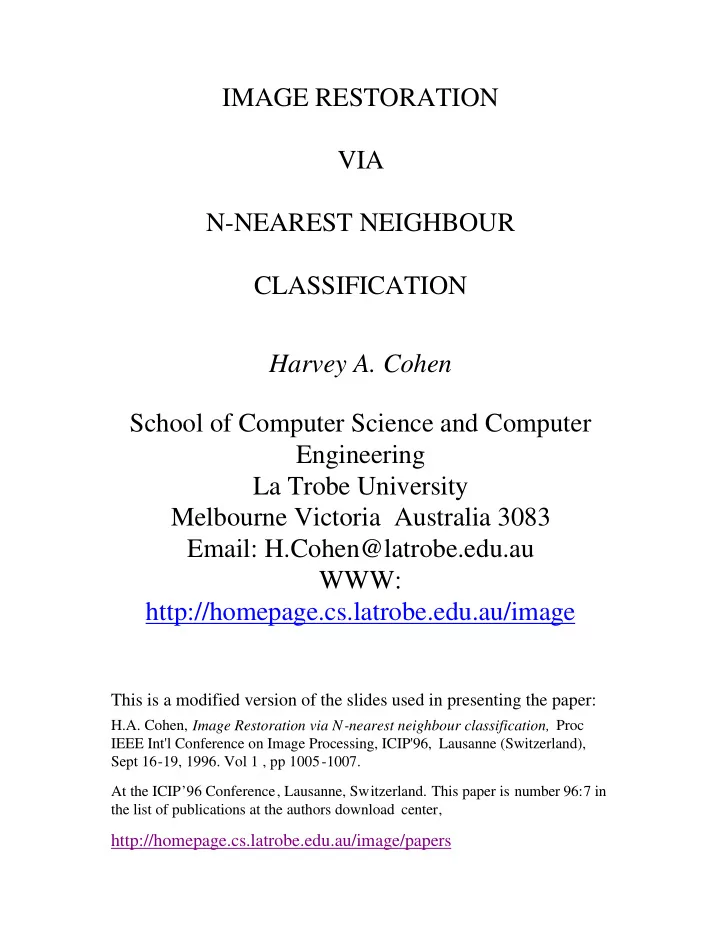

IMAGE RESTORATION VIA N-NEAREST NEIGHBOUR CLASSIFICATION Harvey A. Cohen School of Computer Science and Computer Engineering La Trobe University Melbourne Victoria Australia 3083 Email: H.Cohen@latrobe.edu.au WWW: http://homepage.cs.latrobe.edu.au/image This is a modified version of the slides used in presenting the paper: H.A. Cohen, Image Restoration via N-nearest neighbour classification, Proc IEEE Int'l Conference on Image Processing, ICIP'96, Lausanne (Switzerland), Sept 16-19, 1996. Vol 1 , pp 1005-1007. At the ICIP’96 Conference, Lausanne, Switzerland. This paper is number 96:7 in the list of publications at the authors download center, http://homepage.cs.latrobe.edu.au/image/papers
IMAGE RESTORATION VIA N-NEAREST NEIGHBOUR CLASSIFICATION Harvey A. Cohen ABSTRACT A novel and powerful perpective on image reconstruction and restoration is to regard the computational objective as the classification of corrupt (= unclassified) pixels using the classification of the nearest uncorrupt (=classified) pixels. In N-nearest neighbour (NNN) restoration, the distance transform is used to determine the set of N-or-more classified pixels which are as closer, or closer, than the Nth nearest to each corrupt pixel. NN classification includes classic restoration algorithms, but new algorithms are implied, especially for color and gray-scale images that are very sparse or highly corrupt. We present experimental results for an NNN restoration algorithm, for N=1, using for nearest set classification the median of the one-or- more nearest 'good' neighbours. At low corruption levels this algorithm is equivalent to classic median filtering; for images with random pixel loss of 50% to 90%, satisfactory restoration has been achieved for both gray- scale and colour images.
a new perspection on image restoration restoration of sparse and heavily corrupted images = classifying corrupt or unknown pixels using classification of the N nearest neighbours � Family of Algorithms for which � Pixel = object with attributes gray-scale, colo(u)r, and location � Determine the N nearest neighbours � Use a (sensible) classifying function [ weighted median e.g. [ distance weighted mean [ fuzzy mean Restoration as classifying:
Simple example MEDIAN FILTERING in 3x3 window to eliminate isolated shot noise: (all 8 immediate neighbours ‘good’) J 1 J 2 J 3 J 4 L J 5 J 6 J 7 J 8 (Using chessboard metric - 8 nearest neighbours ) Quasi-Median filtering Replace L by median of J 1, J 2, J 3, J 4, J 5, J 6, J 7, and J 8
NN Classification - restoring a sparse image - massively corrupted image J J d2 J d5 d6 L d3 d1 J J d4 J 4-Nearest Neighbour Classification : Replace L by function of the classification of the 4 nearest neighbours, J 1, J 2, J 3, J 4 AND d1, d2, d3, d4
How to compute distances? What are the NN’s? Which classifier function ? Which distance ? And How? Which pixels are the N-closest ?
Rosenfeld-Pfaltz Algorithm Chess-board Distance Masks 1 1 1 * 1 1 * 1 1 1 Forward Backward Masks Manhattan Distance Masks ∞ 1 ∞ * 1 1 * ∞ 1 ∞ Forward Backward Masks 3,4 Chamfer Distance Masks 4 3 4 * 3 3 * 4 3 4 Forward Backward Masks Fig 1 DT masks. An asterisk (*) is used to denote the mask centre. ∞ is taken as the largest number in the number-set used.
Distance Image Tells how far any (corrupted) pixel is from the corrupted ones -- Geometry of DTs determines where to search to locate ALL the pixels that are closest: NNN restoration Classify corrupt pixel with median of all the equi- distant nearest pixels ( extension of quasi-median to heavily corrupt)
K-NN Restoration Need a REVERSE Distance transform (wait for it)
Locations of GOOD pixels (15%) Black = 0 After forward pass with Manhattan FWD DT mask After the backward pass with Manhattan BK DT mask Distance Colour Coding (Periodic) 0 1 2 3 4 5 6 7 8 9 A B C D E F
Distances from good pixels Distance Image for the 85% corrupted Lena image . = NNN - Restoration Classification by Nearest Neighbour LENNA LENNA LENNA 85% NNN corrupted Restored PSNR = 22.7dBs PSNR = 5.9 dB
Fig 5 From top: 320x200 8-bit colour Clown; Clown corrupted by 85% black pepper noise, PSNR = 9.0452; restored using Manhattan Distance DT and NN restoration. PSNR = 21.6795
Recommend
More recommend